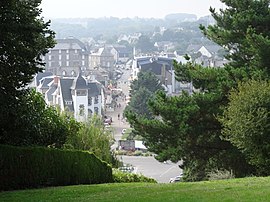Saint-Cast-le-Guildo
Saint-Cast-le-Guildo
Sant-Kast-ar-Gwildoù | |
|---|---|
 Partial view of Saint-Cast-le-Guildo | |
 Coat of arms | |
show Location of Saint-Cast-le-Guildo | |
 Saint-Cast-le-Guildo | |
| Coordinates: 48°37′48″N 2°15′24″W / 48.63°N 2.2567°WCoordinates: 48°37′48″N 2°15′24″W / 48.63°N 2.2567°W | |
| Country | France |
| Region | Brittany |
| Department | Côtes-d'Armor |
| Arrondissement | Dinan |
| Canton | Pléneuf-Val-André |
| Intercommunality | Dinan Agglomération |
| Government | |
| • Mayor (2014–2020) | Josiane Allory |
| Area 1 | 22.63 km2 (8.74 sq mi) |
| Population (Jan. 2018)[1] | 3,311 |
| • Density | 150/km2 (380/sq mi) |
| Time zone | UTC+01:00 (CET) |
| • Summer (DST) | UTC+02:00 (CEST) |
| INSEE/Postal code | 22282 /22380 |
| Elevation | 0–76 m (0–249 ft) |
| Website | tourist office |
| 1 French Land Register data, which excludes lakes, ponds, glaciers > 1 km2 (0.386 sq mi or 247 acres) and river estuaries. | |
Saint-Cast-le-Guildo (Breton: Sant-Kast-ar-Gwildoù, Gallo: Saent-Cast-le-Giledo) is a commune in the Côtes-d'Armor department of Brittany in northwestern France. It is port city on the English Channel as it also has a nautical center, the Centre Nautique de Saint- Cast (CNSC) ranked 3rd to 6th in the nation.
History[]
The Battle of St Cast took place on September 11, 1758, when the French repelled the English. The English first attacked the region of Dinard by sea, but were stopped at the Rance by the Vauban fortifications. They were forced to retreat to their fleet in front of St-Cast, where Emmanuel-Armand de Richelieu was waiting for them and launched an attack on the beach while the British were fleeing back onto their vessels. The casualties were heavy for the British army as they lost 1,160 soldiers: the French lost about 445 men Today there is a monument in the Bourg (neighborhood of St-Cast) showing a greyhound defeating a lion; the Castins defeating a lion (the English symbol).
Population[]
Inhabitants of Saint-Cast-le-Guildo are called castins in French.
| Year | Pop. | ±% |
|---|---|---|
| 1793 | 1,232 | — |
| 1800 | 1,168 | −5.2% |
| 1806 | 1,384 | +18.5% |
| 1821 | 1,444 | +4.3% |
| 1831 | 1,481 | +2.6% |
| 1836 | 1,402 | −5.3% |
| 1841 | 1,421 | +1.4% |
| 1846 | 1,476 | +3.9% |
| 1851 | 1,558 | +5.6% |
| 1856 | 1,511 | −3.0% |
| 1861 | 1,400 | −7.3% |
| 1866 | 1,499 | +7.1% |
| 1872 | 1,380 | −7.9% |
| 1876 | 1,516 | +9.9% |
| 1881 | 1,592 | +5.0% |
| 1886 | 1,553 | −2.4% |
| 1891 | 1,626 | +4.7% |
| 1896 | 1,717 | +5.6% |
| 1901 | 1,717 | +0.0% |
| 1906 | 1,864 | +8.6% |
| 1911 | 2,076 | +11.4% |
| 1921 | 2,013 | −3.0% |
| 1926 | 2,166 | +7.6% |
| 1931 | 2,263 | +4.5% |
| 1936 | 2,201 | −2.7% |
| 1946 | 2,330 | +5.9% |
| 1954 | 2,159 | −7.3% |
| 1962 | 2,179 | +0.9% |
| 1968 | 2,227 | +2.2% |
| 1975 | 3,105 | +39.4% |
| 1982 | 3,165 | +1.9% |
| 1990 | 3,093 | −2.3% |
| 1999 | 3,187 | +3.0% |
| 2008 | 3,487 | +9.4% |
Food[]
Saint-Cast features many of the typical dishes of Breton cuisine, such as the Kouign-amann, or the local specialty, Le Castin, which is originally what we call people from there, or in this case the cake.
Notable people[]
- Lucienne Heuvelmans (1881–1944), sculptor and illustrator
- Irène Aïtoff (1904–2006), classical pianist and vocal coach
- Anne Beaumanoir (born 1923), neurophysiologist, one of the Righteous Among the Nations
See also[]
- Communes of the Côtes-d'Armor department
- https://sites.google.com/site/alderneylocalhistory/Home/1700s/1758-battle-of-st-cast
References[]
- ^ "Populations légales 2018". INSEE. 28 December 2020.
External links[]
- Tourist office website (in French)
- Official city website
- Base Mérimée: Search for heritage in the commune, Ministère français de la Culture. (in French)
| Wikimedia Commons has media related to Saint-Cast-le-Guildo. |
- Communes of Côtes-d'Armor
- Côtes-d'Armor geography stubs


